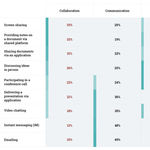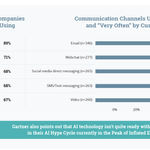Collaboration is Changing Company Cultures

With all the emphasis on digital transformation, topics of employee empowerment have been quietly gaining momentum in the background. At 8x8, we’ve researched this area to better understand how collaboration will be used by companies to enhance employee empowerment (view the infographic at the bottom of this post for a visual representation). These are our top 10 findings from US and UK based companies with 100 or more employees, based on surveys that we conducted between October 2018 and March 2019:
- The most common definitions of collaboration are:
working together towards a common goal
effective communication across departments/individuals in the workplace
- 74 percent are planning to buy audio and video conferencing solutions in the next 12 months.
- Screen-sharing is considered the most collaborative activity.
- Instant messaging (IM) is considered communication, not collaboration.
- Significantly more mid-sized organizations (1,000-9,999 employees) utilize video chatting to collaborate with vendors and customers than larger organizations (10,000+ employees).
- Organizations tend to predominantly share verbal ideas/feedback and documents via all media types, except for IM which is primarily used for sharing meeting information.
- Almost 70% of professionals use instant messaging multiple times a day, followed by audio calling.
- The most prevalent challenges that professionals face when using the collaboration media are connectivity issues, followed by miscommunication due to a lack of face-to-face interaction.
- IT managers indicate that they are significantly more likely to switch to a different application for all services than end-users.
- Overall, professionals predict that their usage of all the media types will remain about the same in the next three years, except for presentation/meeting application usage which they predict will increase slightly.
This type of research invokes the famous quote from Steve Jobs who when asked how much market research was conducted on the iPad and other recently successful products, he responded, "None. It isn't the consumers' job to know what they want." And this article in Psychology Today goes on to explain why that approach makes sense.
This type of research invokes the famous quote from Steve Jobs who when asked how much market research was conducted on the iPad and other recently successful products, he responded, "None. It isn't the consumers' job to know what they want." And this article in Psychology Today goes on to explain why that approach makes sense.
Collaboration is Changing the Culture
The finding on the usage of media types really drives this sentiment home. When thinking about a three-year time horizon, especially in today’s environment of accelerating change, what stays about the same over three years? Other than my 30-year mortgage payment, not much. And, as we speak, the way we work is changing. In fact, it’s happening so quickly and to such a large degree that it’s starting to change company cultures. For example, Dan Metzger, who leads unified communications and collaboration for Conde Nast, made a profound statement, during Enterprise Connect held in March 2019 - “The collaboration piece is ultimately changing the culture of our company.”
This statement highlights a significant trend in the market - companies are quick to include video communications as a key way they want to enable distributed workforces, real-time collaboration, sales, and service.
The key here is “including”. It’s not completely replacing, but becoming a key capability in their communications toolbox. This point becomes clear when looking at what they consider to be collaboration vs communication.

Notice how seven of the nine types of activities are mostly considered collaboration and communication. Respondents are pointing out that they use a wide variety of communication and collaboration tools to get their work done.
So what are they doing? So glad you asked because we asked them as well. Here’s what they said:
Those dark boxes (view the infographic below) indicate a statistically significant difference. For example, the preferred way to share verbal ideas and feedback is using audio calling or video chatting.
And how often are people using each of these types of communication tools? Another good question so we asked them that one as well.
Again, those dark boxes indicate a statistically significant difference. What’s fascinating here is that a high percentage of people are using multiple types of communication and collaboration tools multiple times a day. They are selecting the best tool for the job and that makes sense. Especially if the goal is to empower employees to collaborate and communicate more effectively.

Are people making a conscious choice to align a specific type of communication channel for a specific audience? Turns out the answer appears to be yes. Additionally, there is a difference between the tools midsize companies use vs large companies. All the various communication and collaboration tools are being used between internal audiences. Yet, when it comes to communicating with customers, audio calling takes the lead, while presentation and meetings applications take the lead with clients.
There’s more to this story, but let's stop for a moment and step into the shoes of the IT team responsible for delivering communication and collaboration capabilities for the company. They have an amazingly complex challenge. Modernize communications and collaboration tools to support employee requirements, keep the plane flying while they make the change, reallocate their resources to spend increasingly more time supporting innovation and new business models to drive growth vs just administration and maintenance and keep up with rapidly accelerating technological change. Whew, makes me tired just writing it.
When it comes to modernizing communications, the goal shouldn’t be to just recreate what you have today in the cloud. Yet, that appears to be what’s happening. Of those companies, 70% now have between 2 - 5 communication providers and 22% have 6 or more.
This type of complexity is difficult to administer and manage, requires a good deal of training and adoption across the company and keeps your data in silos. This point is especially important as everyone is trying to figure out how to use AI/ML capabilities today. As everyone now knows, having real-time access to complete, accurate and comprehensive data is the only way to do that.

But, it could be that the current level of complexity is fine. Turns out, not really. About half of companies are still not satisfied with the ease of use, reliability of service, ease of set-up, etc. of their current communications and collaboration situation.
Which brings us back to the initial point of this discussion - the way we work is changing and it appears the speed at which it’s happening maybe catching some companies by surprise. There is also some inherent industry bias when it comes to the rate of change. I hear many companies, across many industries, explain how their industry is different and this “digital transformation thing” is not really relevant to them. It is true that the rate of digitization varies across industries, but the key point is that it is happening - across all industries. Empowering employees to communicate and collaborate more effectively internally and with suppliers and customers is at the heart of any successful transformation. Communication and collaboration solution providers are working hard to convince companies that they have a modern solution. As you evaluate providers, look for one that has voice, video, chat and contact center on one platform. One that can easily and dynamically integrate into your systems of record such as CRM, Service and Support applications to put all the information and capabilities employees need to communicate and collaborate at their fingertips. And make sure that the provider can deliver analytics that incorporates data from all communication touchpoints so you can drive operational efficiency and uncover useful insights from all of your data. 8x8’s X Series can do all of those things for your business.
As mentioned earlier in the discussion, there is more to this story. Stay tuned as we unveil additional findings of the current state of b2b communications and collaboration.Content...


